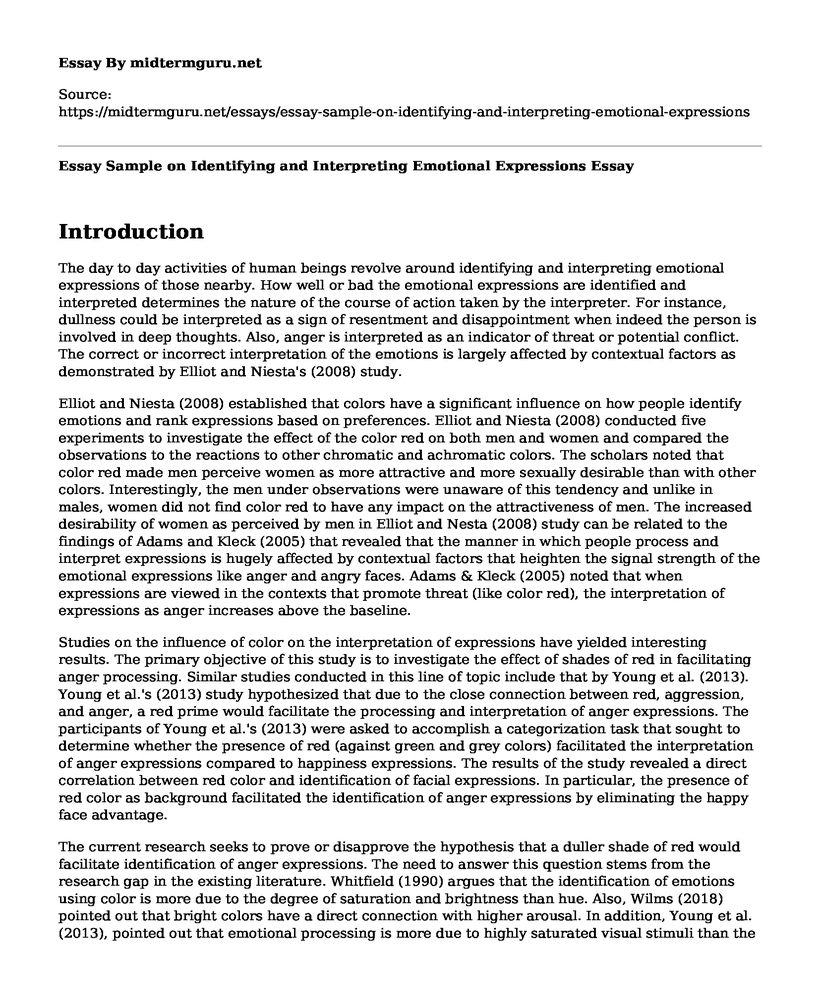Introduction
The day to day activities of human beings revolve around identifying and interpreting emotional expressions of those nearby. How well or bad the emotional expressions are identified and interpreted determines the nature of the course of action taken by the interpreter. For instance, dullness could be interpreted as a sign of resentment and disappointment when indeed the person is involved in deep thoughts. Also, anger is interpreted as an indicator of threat or potential conflict. The correct or incorrect interpretation of the emotions is largely affected by contextual factors as demonstrated by Elliot and Niesta's (2008) study.
Elliot and Niesta (2008) established that colors have a significant influence on how people identify emotions and rank expressions based on preferences. Elliot and Niesta (2008) conducted five experiments to investigate the effect of the color red on both men and women and compared the observations to the reactions to other chromatic and achromatic colors. The scholars noted that color red made men perceive women as more attractive and more sexually desirable than with other colors. Interestingly, the men under observations were unaware of this tendency and unlike in males, women did not find color red to have any impact on the attractiveness of men. The increased desirability of women as perceived by men in Elliot and Nesta (2008) study can be related to the findings of Adams and Kleck (2005) that revealed that the manner in which people process and interpret expressions is hugely affected by contextual factors that heighten the signal strength of the emotional expressions like anger and angry faces. Adams & Kleck (2005) noted that when expressions are viewed in the contexts that promote threat (like color red), the interpretation of expressions as anger increases above the baseline.
Studies on the influence of color on the interpretation of expressions have yielded interesting results. The primary objective of this study is to investigate the effect of shades of red in facilitating anger processing. Similar studies conducted in this line of topic include that by Young et al. (2013). Young et al.'s (2013) study hypothesized that due to the close connection between red, aggression, and anger, a red prime would facilitate the processing and interpretation of anger expressions. The participants of Young et al.'s (2013) were asked to accomplish a categorization task that sought to determine whether the presence of red (against green and grey colors) facilitated the interpretation of anger expressions compared to happiness expressions. The results of the study revealed a direct correlation between red color and identification of facial expressions. In particular, the presence of red color as background facilitated the identification of anger expressions by eliminating the happy face advantage.
The current research seeks to prove or disapprove the hypothesis that a duller shade of red would facilitate identification of anger expressions. The need to answer this question stems from the research gap in the existing literature. Whitfield (1990) argues that the identification of emotions using color is more due to the degree of saturation and brightness than hue. Also, Wilms (2018) pointed out that bright colors have a direct connection with higher arousal. In addition, Young et al. (2013), pointed out that emotional processing is more due to highly saturated visual stimuli than the link between anger, aggression, and red. The lack of a consensus by these studies is the primary motivation for this study. Basically, the study will be similar to Young et al.'s (2013) study only that now the comparison will be between dark red (139,0,0) and red (255,0,0).
Young et al. (2013) study was important in that it laid the foundation for the current study. One of the key differences between the two studies is that Young et al. (2013) used the Nimstim Face Database while the current study used the KDEF Database. In addition, the current study failed to reject the null hypothesis, and hence unable to conclude that highly saturated stimuli (bright red) facilitate anger processing any more than dull red. Importantly, the study failed to replicate Young et al.'s (2013) results in our study, and that could be due to a number of reasons. Overall, the current study was not able to find significant effects in differences between the processing of happy faces and angry faces with regards to red, which does not follow previous literature.
References
Adams, R. B., Jr., & Kleck, R. E. (2005). The effects of direct and averted gaze on the perception of facially communicated emotion. Emotion, 5, 3-11. doi:10.1037/1528-3542.5.1.3
Elliot, A. J., & Niesta, D. (2008). Romantic red: red enhances men's attraction to women. Journal of personality and social psychology, 95(5), 1150.
Whitfield, T. W., & Whiltshire, T. J. (1990). Color psychology: a critical review. Genetic, social, and general psychology monographs.116.
Wilms, L., & Oberfeld, D. (2017). Color and emotion: effects of hue, saturation, and brightness. Psychological Research, 82(5), 896-914.
Young, S., Elliot, A., Feltman, R., & Ambady, N. (2013). Red enhances the processing of facial expressions of anger. Emotion, 13(3), 380-384.
Cite this page
Essay Sample on Identifying and Interpreting Emotional Expressions. (2022, Dec 21). Retrieved from https://midtermguru.com/essays/essay-sample-on-identifying-and-interpreting-emotional-expressions
If you are the original author of this essay and no longer wish to have it published on the midtermguru.com website, please click below to request its removal:
- Essay on the Person Who Inspired Me Most: Kim Min Jong
- Paper Example on Strategic Family Therapy
- Research Paper on Training for Clinical Supervisors
- Mental Health: Essential From Childhood to Adulthood - Essay Sample
- Overcoming Language Barrier: My Experiences in Group Therapy - Essay Sample
- Attention Deficit Hyperactivity Disorder and Criminality Continued Care - Research Paper
- Unchained Melody: A Timeless Love Song Inspired by a Prison Movie - Research Paper







